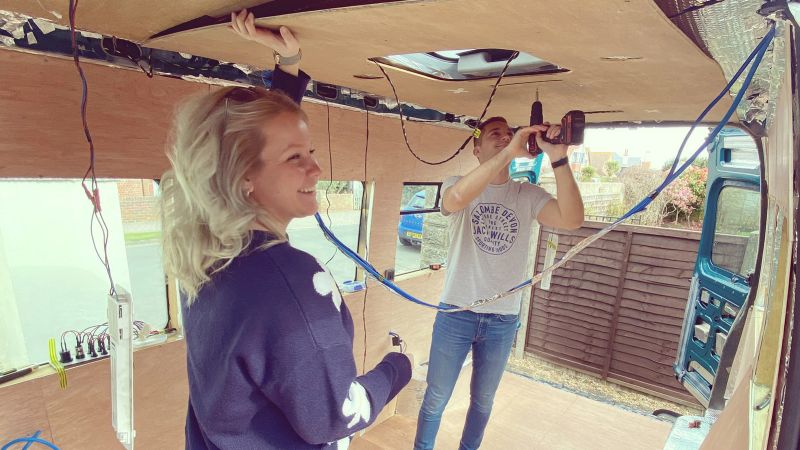Search the #vanlife hashtag on Instagram and you’ll find millions of posts from travelers on the road in tiny homes on wheels.
While some van lifers will have opted to buy readymade campervans, more and more are choosing to buy a van or bus and convert it themselves.
Of course, this is hardly a new phenomenon. Campervan conversions have been around since at least the 1950s.
However, their popularity has skyrocketed in recent years. Demand had already increasing significantly before the pandemic, partly due to the numerous YouTube channels and Instagram posts devoted to DIY van conversions.
But interest went through the roof as many people found themselves stuck at home with little to do as borders shut down and restrictions were put in place in many destinations around the world.
“People wanted to get out. They wanted to get away from other people and stay safe, and we were all limited in what we could do,” Brian Jagodnik, marketing and creative director at Outside Van, a luxury van conversion company in Portland, Oregon, told CNN Business last year.
“It pushed people outside and to travel away from others and take the road less traveled, and so the industry just continued to grow.”
As a result, the #vanlife community is expanding further, with an increasing amount of travelers, many of whom may have already been mulling over whether or not to get a van, making the decision to buy one, and in some cases, do it up themselves.
So how difficult is a DIY campervan conversion? And are video tutorials and social media posts really enough to get you through a van build? Here, we talk to a number of travelers who’ve taken the plunge themselves.
“It’s functional and not too fancy”
Dale Comley and Charlie Low, both from the UK, purchased a yellow Mercedes Sprinter for £8,000 (around $10,500) in 2019 and spent roughly £6,500 ($8,500) converting it into a campervan. The couple now live in their van Ringo full time and have written a book about van conversions together.
Investing in a van was a no-brainer for Comley and Low who met on a climbing trip and have been together for almost six years.
“It’s something that we both always wanted to do since we met,” Low tells CNN Travel.
“We’re both from a climbing background, and climbing and van life are fairly synonymous. If you go to any climbing areas, you’ll see lots of vans. We decided to take the plunge in June 2019.”
Like many other travelers, they chose to buy a van and convert it themselves rather than splashing out on a readymade motorhome. That way they could create something that was tailored to their needs and tastes.
“The great opportunity with converting your own van is that you don’t need to fall into the trap of essentially buying a motorhome and being stuck with one layout,” says Comley. “You can truly create whatever you want.”
Once they’d purchased the van, the couple parked it at Low’s mother’s house, where they had more space to work, and took time out to plan the design and layout.
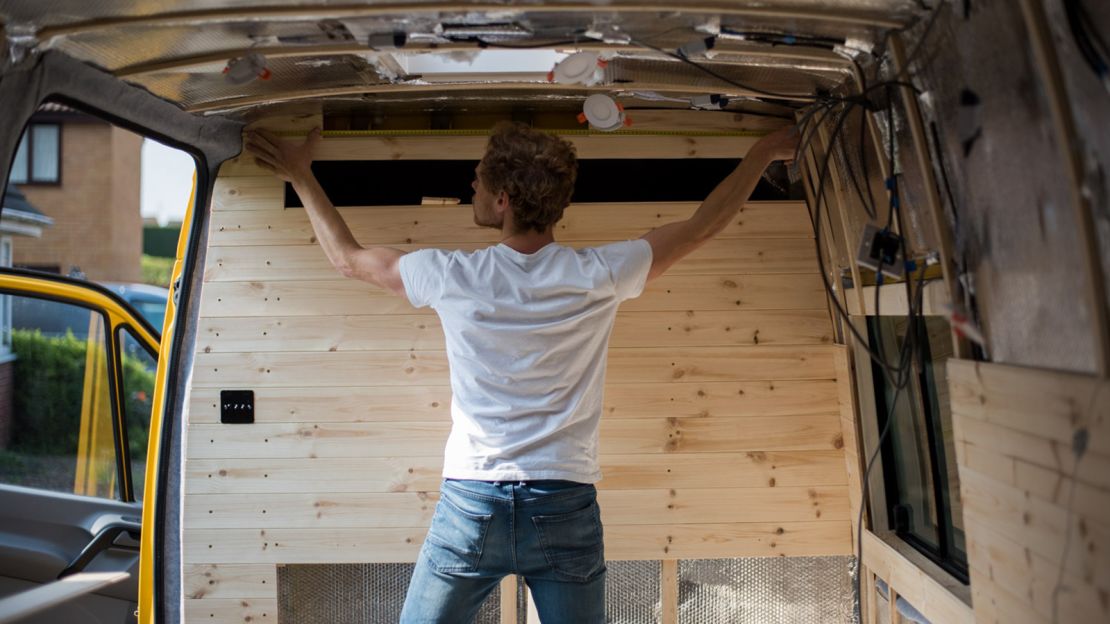
“We’re both fairly practical,” says Comley. “So we spent a long time designing so that we essentially got it right the first time.”
They completed a lot of research on YouTube, but say they found that everyone had different ideas about the best way of doing things.
“There wasn’t really a definitive single source of information,” says Comley. “There were hundreds or thousands of opinions that weren’t really founded in any sort of fact. It was all personal experience.”
They began by gutting the van, before fitting in windows, as well as skylights and solar panels. The next step was insulating the van, before installing the electrical system and cladding.
They then built their bed, their kitchen, with a Belfast sink, overhead cabinets and other necessary structures, before installing the water and gas systems.
Once all of that was done, they were able to begin decorating their mobile home, which meant painting the walls, putting tiles in the kitchen area and upholstering the seats.
Although they had a few false starts, where they followed someone else’s method and found there was “something fundamentally wrong with what we’d been told to do,” the pair, who documented the entire process on their Instagram account, say the build went smoothly overall.
“Provided you’ve got a bit of a process to follow, and you spend some time designing it, there’s not really any single job that is very difficult,” says Comley.
“All of the practical stuff is quite quick and simple. You don’t really need any specialist tools and you don’t really need any experience.”
If in doubt, travelers have the option to hire professionals to help with parts of the build they’re less confident about.
“It’s very possible to just outsource one part of your van build,” adds Low.
The couple say it took just over a year, or the equivalent of around 1,000 hours between them, to complete the van.
“It [the van] is a nice standard. It’s functional and not too fancy, which is basically us. So it would be quite easy to spend significantly more [or less] if you wanted to,” says Comley.
“Our original plan was that once we’d finished the van, we’d go traveling for a year,” says Low.
“But what happened in reality was that we finished the van, and then a week later, the UK went into lockdown. So it was fairly appalling timing.”
It was at this point that they decided to write a book, “The Van Conversion Bible,” with the aim of preventing others from making some of the same mistakes they did.
“You can kind of fall from one hole into another, into another, into another,” explains Comley. “Some cost you financially, and some cost you time.
“So that’s really why we wrote the book. To try to help people avoid as many of those holes as possible.”
The couple, who also have a van conversion blog, were finally able to go on the road when travel restrictions eased around the world, and have since traveled to France, Switzerland, Spain, Albania, North Macedonia, Montenegro and Croatia.
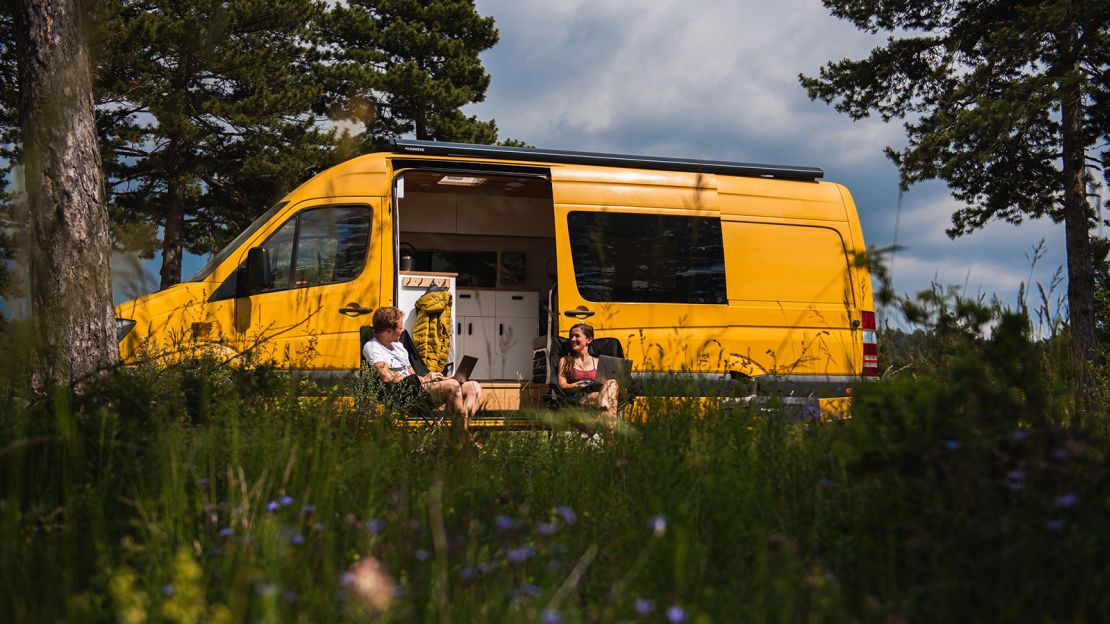
“It [the van] is going to allow us to explore countries that realistically, we probably would never have gotten to,” says Comley.
They’ve been living in their van Ringo for around a year now, and believe that anyone can convert a van, provided they stay focused and think of the project in stages
“When you think about converting a van, it feels quite scary, potentially, and not possible,” says Low.
“But if you break it down into all of the different things you need to do, and then you kind of learn about each individual thing, it makes it feel a lot more manageable.
Comley also recommends that travelers try going on at least one van trip before even thinking about spending time and money on a conversion.
“Make sure you actually like it,” he says. “Irrespective of how good it [the van] is, you’re going to spend a lot of time and probably money working on it.
“I’d say the most common mistake that people make is, if anything, is spending more time converting the van than actually using it.”
Jennifer Mckechnie from Northern Ireland bought a minibus for £2,300 (nearly $3,000) in 2019 and spent around £3,500 (around $4,564) converting it into the campervan of her dreams. The former fitness instructor has since set up her own campervan conversion business and completed six conversions last year.
“I used to go snowboarding every year to Chamonix,” Mckechnie tells CNN Travel. “And I remember being in a bar once and I saw a video of a guy who had a van. He was traveling around snowboarding. I thought, ‘Oh, I’d love to do that.’ “
One of the biggest attractions of van life for Mckechnie was that she’d be able to travel around with her two huskies in tow.
“I love traveling to different countries and going snowboarding, but I’ve always wanted to take my dogs with me. So it [getting the van] was purely so that I could drive to Chamonix and bring them along.”
After spending a bit of time watching YouTube videos and reading articles on how to convert a van, she purchased one in 2019.
While Mckechnie had planned to work on the van on weekends mainly, she found herself with a great deal of time on her hands when the pandemic set in and she was unable to work.
“Everything else in the world was closed,” she explains. “So I didn’t have anything else to do.”
She began by stripping out all of the seats in the van – there were 17 in total – before removing the walls and floor.
“I basically stripped it back to a bare metal shell, and then started from there,” says Mckechnie.
The next step was covering corrosion on the floor with rust converter, then filling in gaps in the walls, floor and ceiling and insulating the van.
After installing the walls, the ceiling and the electrics, Mckechnie took some time out to design the layout of the van.
“The biggest problem was that builders merchants and things like that were closed,” she says. “So it was hard to get materials.”
Mckechnie was able to complete all of the labor herself and says she spent a total of 100 days on the build.
“I had my dad help me put the ceiling up, as it takes two sets of hands to do that,” she explains. “But I did all of it myself.”
A friend persuaded her to share a video of her renovation work on TikTok, and Mckechnie was soon inundated with messages from travelers asking her to build them a van.
“Everyone was saying, ‘I want one. Can you build me one?’” she says. The post went on to receive around 14 million views.
Once she’d mulled things over, Mckechnie eventually said “yes” to one of the van build requests.
“I decided that I’d give it a go,” she says. “And if it didn’t work, I’d just go back to doing what I was doing.”
However, Mckechnie went on to receive so many bookings that she decided to quit her day job and set up a bespoke van company. She now spends her days building custom campervans for other travelers and says business is booming.
“This was never the plan,” she says. “But here we are.”
Once her own van was complete, Mckechnie went on her first road trip with her dogs and says everything went smoothly.
“I did have a couple of people ask ‘what happens if you hit a speed bump? Does it all fall off?’ she says. “But it actually went really well and the dogs enjoyed it. The only thing that probably moved would be the cushions.”
Ironically, the success of her company, Custom Conversions NI, has meant that she hasn’t been able to travel in her van much over the last few years.
“The last time that I used my van was August of 2020,” she admits. “I’m fully booked for the next 12 months. It’s madness.”
However, there’s nothing she enjoys more than sending travelers off in a campervan that’s been customized just for them.
“They tell me what they want and I build it that way, as opposed to them buying a motorhome or a van that’s already been converted and may have things in it that they just don’t need,” she explains.
According to Mckechnie, the most unusual request she’s had so far is a sliding wardrobe.
“I did manage to put that in there,” she says. “But I think sometimes people forget that we are in a little square box, so you have to think about the necessities.”
Although each traveler will have different ideas on what they consider essential, for Mckechnie the basics tend to be “a bed, a kitchen, somewhere to charge your phone, a couple of lights, and if you have the space, a portable toilet.”
Mckechnie occasionally helps her customers find a van before beginning a conversion and has noticed that prices have shot up in the three years since she converted her own van.
“They’re like gold dust at the moment,” she says. “Everyone knows how popular it [van life] is.”
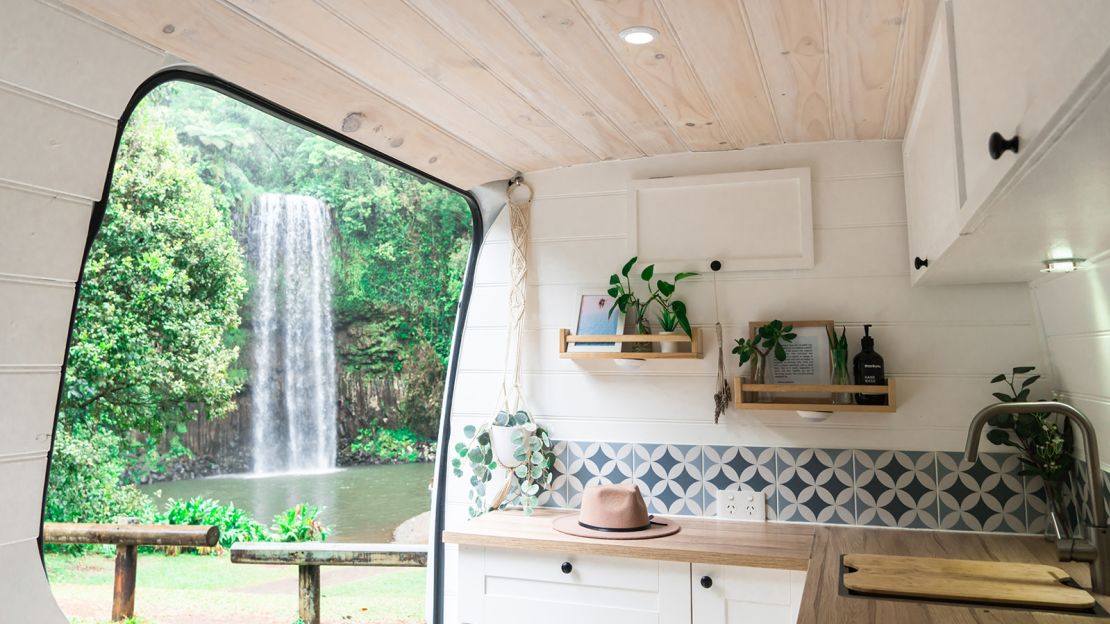
In January 2020, Claire Falconer and husband Luke Morris left Dubai and relocated Down Under, where they bought a Mercedes Sprinter for 32,000 Australia dollars (around $23,740) and spent roughly $13,470 converting it into a fabulous home on wheels.
They were both living in Dubai when they first got together, but after several years in the emirate, Falconer and Morris decided to pack up and move to Falconer’s native Australia.
“Luke and I have always loved traveling, it’s in our blood,” Falconer tells CNN Travel via email. “We have seen a lot of the world and it was always my dream to return to Australia one day and finally travel my home country.”
Once they began investigating the different ways they could travel Australia, they decided to go down the van route.
“I didn’t really know about the whole van life movement in much detail until I started looking into it, and realized how big and how amazing some of the vans are,” says Morris. “I really had no idea what I was getting myself into.”
They say they opted to go with a van instead of a caravan, “just for the flexibility of being able to park up at the beach and things like that,” and were keen for something with a high roof so that Morris, who is six foot two inches tall, would be able to stand in it.
The couple purchased a Mercedes Sprinter just a week after arriving in Melbourne, and got started on the build pretty much immediately.
They were working out the layout and some of the finer details when the pandemic hit, and Melbourne went into lockdown in March 2020.
Thankfully one of the few shops that remained open in the city was a hardware store, so they were able to get hold of many of the materials they needed and “just cracked on with the build for the whole of the lockdown.”
Before the conversion, Falconer and Morris say they’d done very little DIY work other than putting furniture together. However, they threw themselves into the build completely, sharing their experiences on their Instagram account.
“It was honestly great; we work super well together as a team,” says Falconer, who works as a health coach and a yoga teacher. “Obviously building the van had its tough moments, but for the most part we loved doing it.”
Falconer had been following various van life accounts on social media for a while and says she’d picked up lots of design inspiration.
“When it came to color schemes, she wanted it all white, beachy and quite premium,” says Morris, who own and runs eco-friendly accessories company Wild Wood.
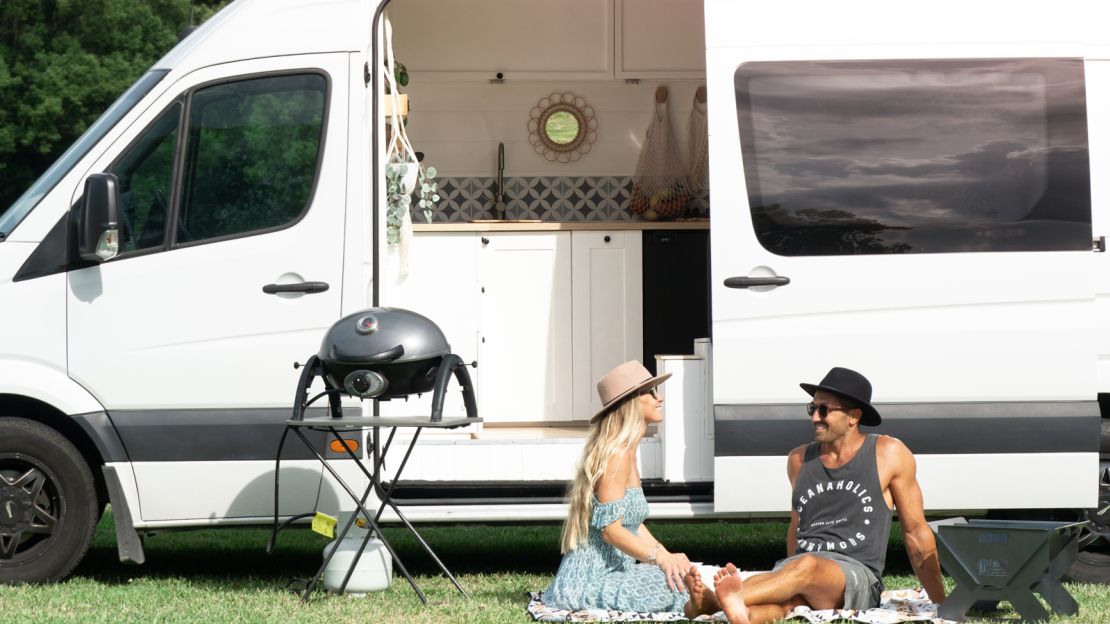
After a bit of deliberation, they chose to put in a partition wall between the cab and the living space rather than keep the space open.
“That [the partition wall] is quite controversial in the van life world,” says Morris. “I guess it’s because people generally want access from the cab to the living space, but we didn’t see the need for that.”
Although much of the build process went to plan, they found themselves in a sticky situation when they settled on putting up real tiles in the kitchen area and used the wrong type of adhesive, which meant they had to rip them out and start again.
“That was a bit of a nightmare for a couple of days, just because it was so time consuming,” says Morris.
While Morris was initially determined to complete all of the work himself, he eventually chose to outsource the electrics and the plumbing work to experts so that he could focus on the parts of the build that he felt more comfortable with.
“You need to get an electrical certificate, and a plumbing certificate to actually sign it off as a motor home anyway,” he adds.
If they happened to be struggling with any part of the build, Falconer and Morris say they would reach out to others for advice.
“People in the van life community are extremely helpful with that kind of thing, they are willing to give you advice and actually help you out,” says Morris.
The couple say it took around four months to complete the van, with their total spend came to 52,207 Australian dollars (about $38,732) including registration, stamp duty and insurance costs, which was more or less what they’d estimated before beginning.
“Some of the things were a little more expensive [than we thought],” says Morris. “But nothing too crazy.”
Falconer and Morris welcomed their son Beau in April 2021 and admit that living in a campervan with a baby has proved to be extremely challenging.
“Our lil’ man doesn’t stop,” says Falconer. “He’s so, so active, so we have struggled with that a bit on the road, as its hard to always keep him out of trouble.
“We can’t just leave him to play like we would in a house. One of us constantly needs to be on him. But we absolutely love traveling with him and having him by our side at every moment.
“There is something so special about seeing the world through his eyes.”
Due to the regional Covid-19 border restrictions in Australia, they haven’t been able to explore as much of the country as they’d have liked, or see many of their family and friends for the past two years.
They’re due to visit Asia to see family and friends the coming weeks, but will be taking off in the van again once they return to Australia in a few months time.
“It will be winter here, so we’ll be driving north pretty quickly to get into some warmer weather,” says Morris. “Then we can finish off doing everything that we missed while borders have been closed. That will be really exciting.”
‘My heart and soul went into it’
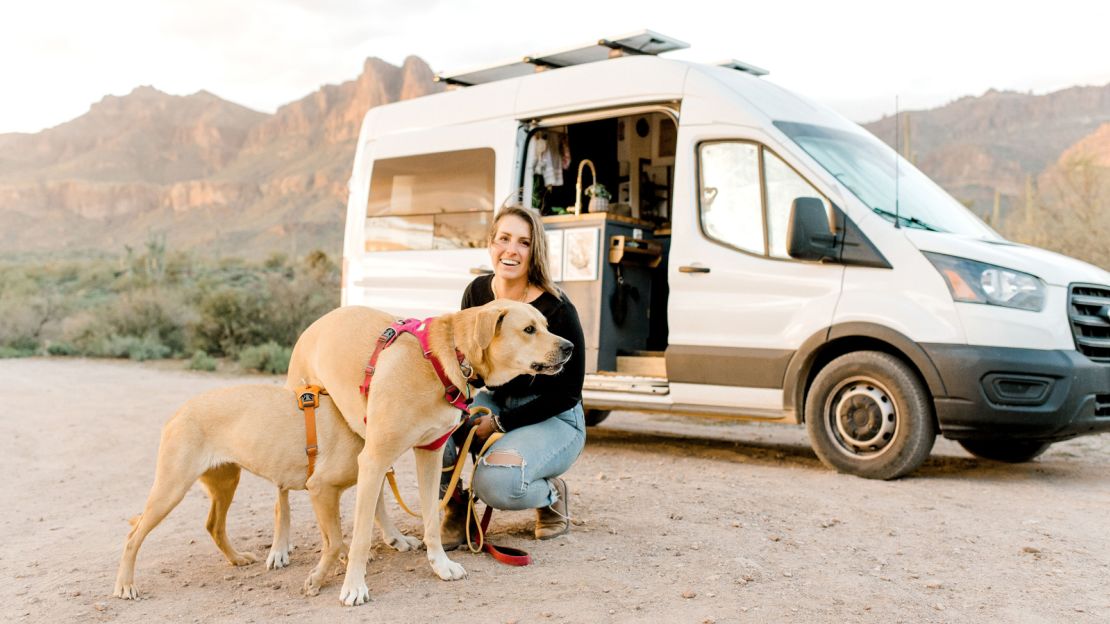
Cori Geiger bought a used Ford Transit in 2020 for $36,000 and spent around $19,000 converting it into a campervan that she could live and work in remotely while traveling around the country. She is now based in her van, named Cadia, full time.
Geiger, from Massachusetts, had often dreamed about going on the road in a campervan, but it wasn’t until the pandemic set in and her job as a senior project manager went fully remote, that she felt ready to give van life a try.
“I really didn’t want to be paying rent in a city,” Geiger tells CNN Travel. “I wasn’t going to be commuting into an office anymore, and I wasn’t ready to buy a house – prices are crazy in the US right now. So this made the most sense for my life.
“I could work remotely and travel around and see the country at the same time.”
According to Geiger, one of the main reasons she decided to convert the van herself was because pre-built van conversions were significantly more expensive.
“They can be over $100,000,” she says. “So I didn’t want to go that route, and I wanted the challenge of building it myself. That way I could actually control how much I was spending during the build.”
Geiger had already been watching online videos about van life and tiny homes for a couple years before deciding to build her van, so she had an idea of the type of layouts she liked, as well as how much work she’d need to do.
Once she’d purchased the van, Geiger began the conversion, working her way through the project step by step.
“It starts with building the insulation and prepping the van for everything that you’re going to be putting on to it,” she explains
“That means putting down the floor and the framing that you’re going to be drilling the walls into and putting things on the outside.”
Although she had little experience with renovation work before starting the build, Geiger found that she picked things up relatively quickly for the most part.
“My skills were very basic,” she admits. “So learning how to use power tools and measuring stuff, that was definitely a learning curve. But it was really fun working through it all.”
Aside from calling on her family to help with tasks that required “multiple hands,” Geiger was able to complete the build on her own.
“It was really important to me that my van felt like an apartment or a cozy home,” she adds. “The layout was also really important, I had a really big dog at the time – I now have two dogs.
“So I wanted an open layout where she would be comfortable while I was working full and I wanted an open space.”
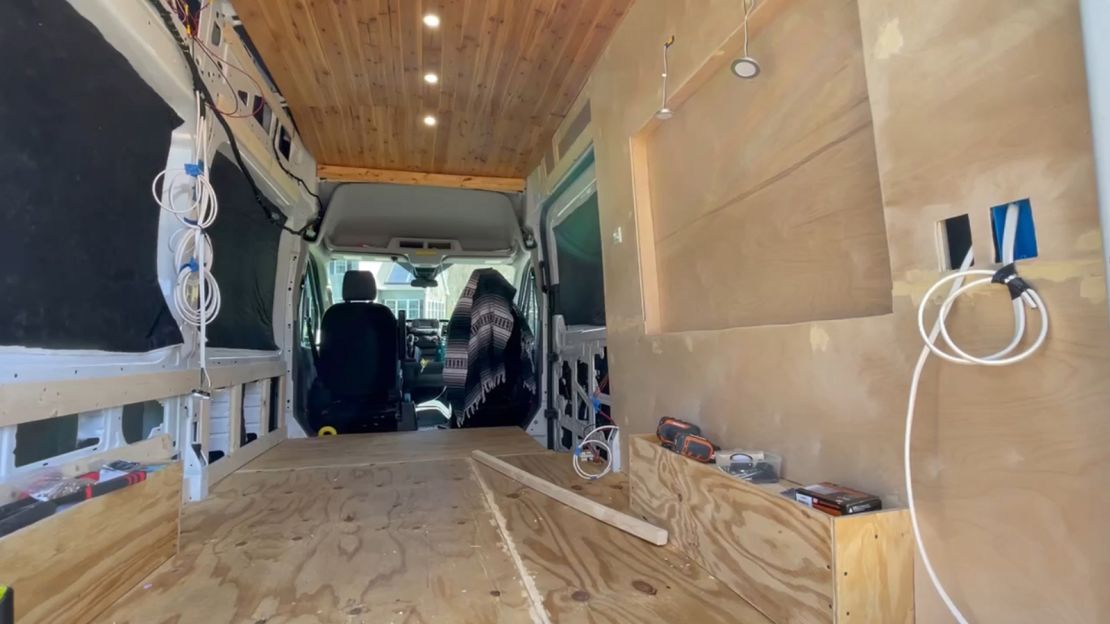
Geiger was able to achieve this by building a Murphy bed design, which folds out of a wall or cabinet, into the van.
“That really changed the game for me,” she says. “It goes down while I’m sleeping, but then it goes back up against the wall, which means I have a lot more space. I have a full living room area.”
Geiger also has a full sink with a large faucet, which she uses as an outdoor shower. She says she spent $3,192 on the exterior accessories, including a ladder, roof racks, and a security system, and an extra $4,236 on building supplies, along with tools, wood and other materials.
The electrical system set her back around $5,667, which included power sockets and wiring, and the plumbing costs worked out to $1,253. Finally, the cost of interior accessories, paint and other design elements came to $5,528.
“I love showing people my van, because my heart and soul went into it,” she says.
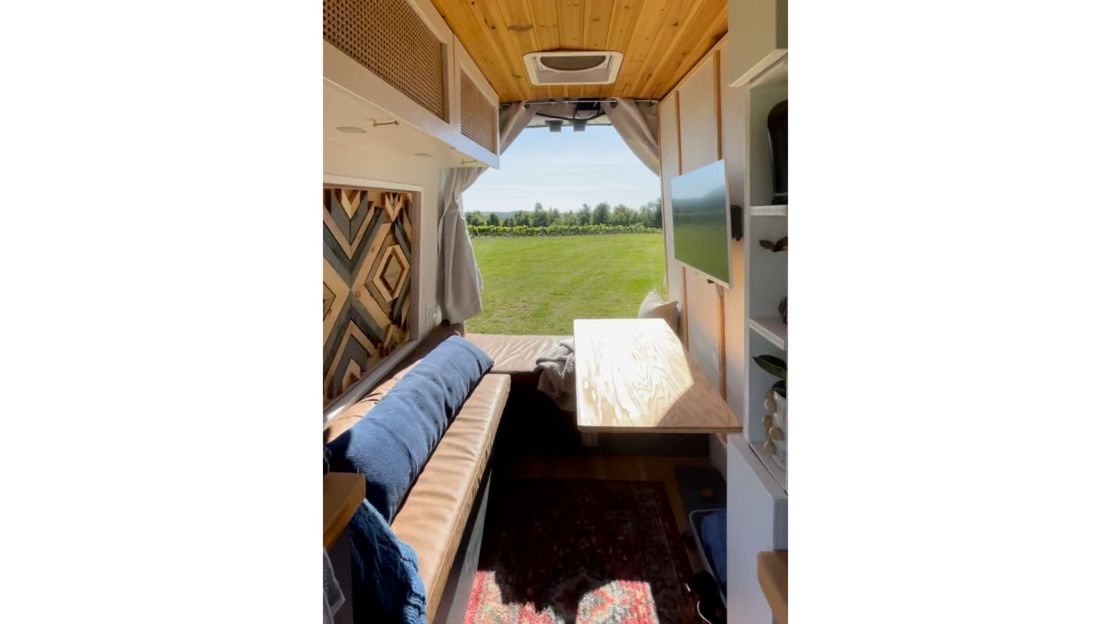
Geiger set off on the road back in September 2021 and says she hasn’t looked back. While she admits that a few issues have cropped up with the van along the way, such as her water pumps freezing up, she’s been able to deal with them thanks to the skills she learned during the build.
“Just living van life, there’s so many problems that you have to solve every day,” she says. “But you get used to it because you built the van, and you had to problem solve through the build.”
Geiger has found being part of van life truly life changing and urges others who are keen to try it out not to wait too long.
“Don’t wait for retirement,” she says. “I talk to so many people on the road. And the number one thing they say to me is, “it’s awesome that you’re doing it so young, I wish I had done it earlier in my life.’
“So if it’s something you want to do, you should do it. There will always be hard days and tough days, but you will be so much stronger, happier, fulfilled and proud of yourself after you finish a project like this.”
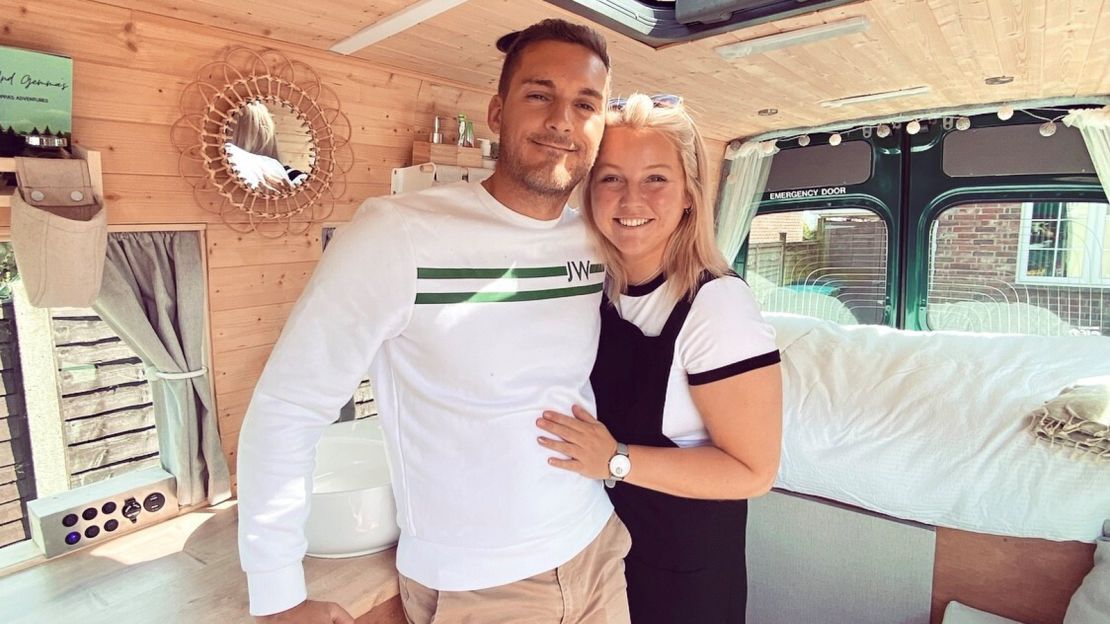
Matthew Dacombe and Gemma Hitchcock bought a green wheelchair accessible minibus for £4,500 (around $5,868) in 2020. It took them around eight months to convert it into a campervan, at a cost of around £5,500 ($7,170). The couple, who are both teachers, got engaged during their first trip and plan to incorporate their van, the Happy Hoppa, into their wedding.
When their plans to travel around Europe by train fell through due to the pandemic, Dacombe and Hitchcock began searching for alternative ways to see the world together once borders reopened.
While they’d previously discussed the possibility of getting a campervan, they say it was witnessing another couple relaxing in a converted van during a trip to the beach that helped them finally make the decision.
As the UK went into a second lockdown in 2020, Dacombe and Hitchcock drew up a plan for the layout of their dream van on the back of a brown envelope and began the project.
“We’ve still got the envelope now,” says Hitchcock.
They originally setting themselves a budget of £8,000 (around $10,430) but realized they were likely to go over when they began looking into vans, and found a minibus for about $5,868 that they couldn’t resist.
“I remember just staring at the back of this bus, thinking ‘oh gosh. What have we done?” admits Hitchcock.
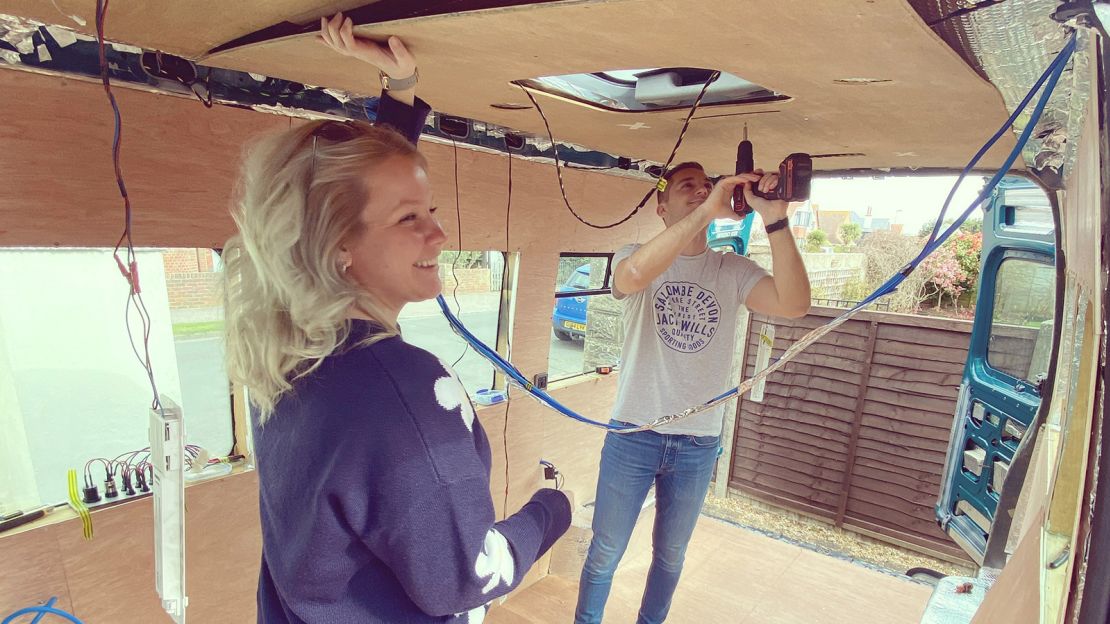
The couple say they didn’t really plan out the build in much detail before beginning, but would take on something new week by week and reach out to other van lifers for advice.
Determined to keep costs down, they completed the entire renovation using just a jigsaw, a drill, a hand saw, a spirit measure, a screwdriver, a sander and a workbench.
“We tried to go as minimal as possible,” says Dacombe. “We pretty much built the whole van on just wooden battens and plywood. Even the doors of the cabinets and all our drawers.
“They all came from plywood. We kept it cheap, but we’ve got good quality products.”
Not only has this method saved them money, it’s also helped to keep the weight of the van down.
The maximum weight restrictions for motorhomes and campervans within the UK and Europe tends to be 3.5 tons. If a vehicle is over the legal weight limit, owners are required to upgrade their driving license or they could face fines.
While Dacombe and Hitchcock did the majority of the work themselves, the couple used a specialist company for their electrical system.
“Going into it, I was quite confident with the appearance of converting a van,” says Dacombe. “But electricity was another ballgame. You don’t want to get that wrong.”
They also brought in professionals to help remove some metal flooring that had been glued to the floor of the van.
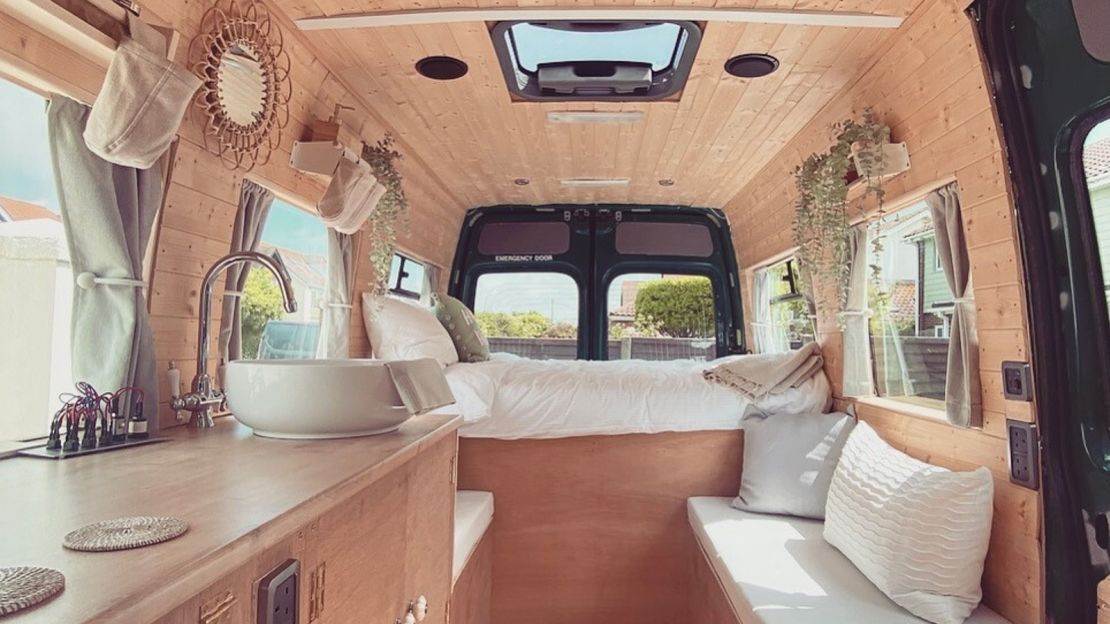
Once they’d cladded the walls and the ceiling of the van, built a bed frame and cut their mattress to size, the next big task was building an L-shaped kitchen with a sink in the remaining space, and constructing their sofa areas.
“That’s when it got really exciting,” says Hitchcock. “Because we could actually see what we’d planned on the brown envelope.”
The conversion took eight months in total. Hitchcock says she was very particular about how she wanted the van to look and would come up with new ideas at the last minute.
“I wanted it to be very beachy, very wooden and fresh,” she says. “We really wanted to maximize all of the windows on the bus.”
A few days before they were due to leave on their first trip in the van, Hitchcock decided they needed a wine rack for their fridge.
While this proved to be a tricky task, Dacombe created one that could fit inside by cutting a double wine rack in half, and both say it has come in extremely handy.
“Gemma’s the interior designer and I’m the laborer,” he admits. “But I don’t think we’d have been able to do it without both of us chipping in on both sides.”
Dacombe bought an engagement ring shortly before they set off, and was waiting for the right moment to propose.
He ended up popping the question on the beach later that same evening after they’d parked up at Durdle Door in Dorset, a coastal beauty spot in southwest England, and were watching the sunset together.
“I had the ring, I had asked Gem’s mum and dad for permission and I knew I would be doing it during our travels,” says Dacombe.
“But the first evening, with the surroundings of Durdle Door, the sunset, the feeling of what we had just achieved together… It was the perfect moment.”
After putting so much time and energy into creating their van, the couple, who also detail their adventures in the van on their Instagram account, are hugely proud of it, and say they often get compliments from onlookers.
“We’ll be parked up and sitting on the bed having a glass of wine or whatever and people are constantly coming to ask if they can have a look inside,” says Hitchcock.
“They’ll say, ‘oh my goodness, your van is stunning.’ That’s something that hasn’t really gotten old.”
Read the full article here


